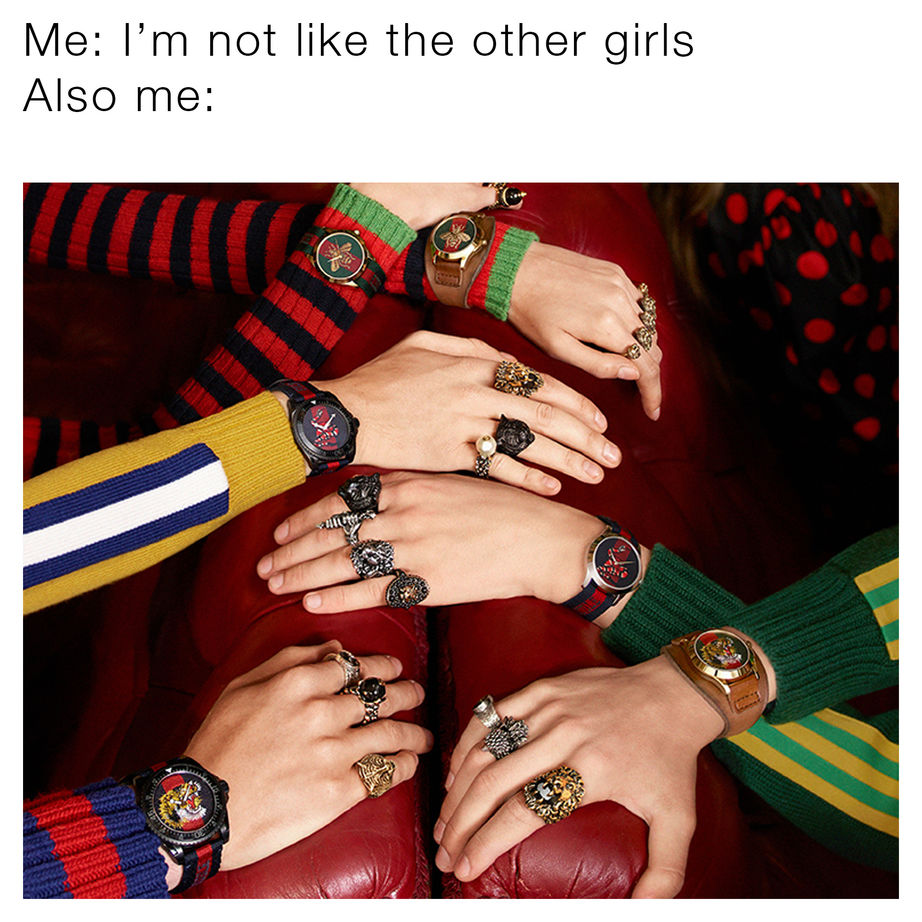Goth Shakira is the Latinx mememaker all your woke faves are following on Instagram. The Montreal resident – and self-anointed High Priestess of Dank Memery – has amassed a devoted following for her intersectional feminist commentary, which she packages in meme formats that often reference celebrities like JLo and Selena Gomez. Taken altogether, the images are part of a new genre of internet humor – one that leverages the aesthetics and framing of popular memes but adds in long-winded captions that speak to the experiences of broke, 20-something creative millennial women (fuccbois, depression, the exotification of Latinas, and gender fluidity are just some of the themes she touches on).
https://www.instagram.com/p/BPJm0JjAsov/?taken-by=gothshakira
While Goth Shakira’s buzziness had already put her on the radars of many, her profile got a boost last month after she collaborated with luxury fashion brand Gucci on an ad campaign built around memes. The #TFWGucci campaign – a riff on popular “that feeling when” meme construction – commissioned 31 “international meme creators” to create original Gucci memes about the brand’s Le Marché des Merveilles collection of watches. It drew a divided reaction that reflects the pushback brands are increasingly facing as they try to woo a more politically active, socially conscious and digitally native young generation.
With the internet upending traditional approaches to advertising, many brands have found themselves at a loss for how to gain traction with millennial audiences – many of whom are disillusioned with a capitalist system that has let them down. Their answer? To try and become relatable by communicating the way we do, about the subjects we care about. (This is why you often see cringe-worthy Tweets from Taco Bell using terms like “on fleek”, or commercials like the latest Pepsi fiasco with Kendall Jenner.) But today’s young people aren’t really buying it. And they’re asking pointed questions about who stands to benefit when corporate America cashes in on internet cool or social justice movements in an attempt to remain relevant.

These are precisely the types of questions that came to the fore when the internet saw its favorite meme-makers get tapped by Gucci. While some fans were happy that artists like Goth Shakira were being compensated for their innovative digital art forms, others saw “selling out.”
However, when we’re discussing digital-borne artwork made by artists of color who rarely see compensation for the content they create, the discussion becomes more complex.
I must say that when I first saw the Gucci memes – many of which repurposed traditional formulas like as the Arthur clutched fist, the starter packs, and historical art images juxtaposed with first world issues – I felt the same way I did when I found out Kanye made a zine. Kanye, internationally acclaimed musician and producer, self-publishes a DIY magazine? Excuse me while I roll my eyes. The siphoning of culture from the creative class, particularly creatives of color, by corporations is real. Urban Outfitters sells clothing I find at thrift stores – most recently, Selena t-shirts. It’s a type of eating the other. “Within commodity culture, ethnicity becomes spice, seasoning that can liven up the dull dish that is mainstream white culture,“ says bell hooks.
The question is: can you be politically-conscious and get paid by big corporations at the same time?
But once you understand the general attitudes toward creative labor, it becomes clear why this happens. Not only is there a common stance that creative work should be consumed but not paid for, but we also live in a culture where the “gig economy” powered by artists and creatives encourages you to overwork yourself. Without content-creating artists, technology platforms like Instagram or Tumblr would be worthless, but there is no structure to pay the artists making the content. How are internet artists supposed to survive without taking the gigs they’re offered in an economy where all the power players – those with hiring-power and money – are corporations?
We can’t overlook the fact that Goth Shakira’s platform of choice, Instagram, relies on but does not compensate content creators. And there’s the fact that the internet also facilitates quick rip offs of original work. Since she began gaining online traction, several other accounts have mimicked Goth Shakira’s style of the verbose headline coupled with an expressive celebrity – at this point, the style is ubiquitous in the meme world. Does the internet know she started that meme form? Is she getting paid each time someone samples her style? The simple answer is no. So how then does an internet artist like Goth Shakira get paid for her work?
I do see why some were disappointed. Goth Shakira’s content is specifically “woke” and critical of the dominant societal constructs like capitalism, patriarchy, and misogyny. At one point she dubbed herself an “anti-heteropatriarchal/ anti-capitalist nonbinary meme priestess.” So the question is: can you be politically-conscious and get paid by big corporations at the same time? Does the concept of “use the media, don’t let the media use you” apply here? As blogger Queer Xicano Chisme tweeted in response to critiques leveraged at Goth Shakira, “Apparently if we ain’t struggling/starving we ain’t really conscious™/feminists™/down with the struggle™.” There is a widely held belief that to be a politically-conscious artist, you must do your work for free in order to keep intact the romantic idea of a sad and struggling artist. It’s unsustainable.
Goth Shakira’s whole practice bloomed out of her struggles with depression, with being broke – and her work was created as a way to relate. It seems her art has done what it set out to do, to get people to say, “me too!” And now she has connected with such great swaths of the internet that she got the attention of an international brand. Can we be a little happy for her now that she can pay off some debt? We do all live in the same world powered by capitalism, after all. What is her alternative?
Let us not forget that Selena did a Coca Cola campaign, as have many other Latinos. Coke – the bubbly brown beverage giving our tíos and tías diabetes across borders. And would the brown internet EVER talk shit about that angel? Remember the scandal after it was revealed that JLo did not actually appear in the Fiat 500 ad that showed her cruising in her old neighborhood in the Bronx? As journalist Ed Morales, who broke the story, revealed, Lopez used a body double for the commercial because Jenny from the Block was actually too busy to visit her old hood. “It’s a classic case of Jennifer, or any celebrity, who comes from a lower-middle class background, who tries to publicly identify with the class they come from,” he wrote. “But maybe we should give her credit for trying to make that connection,” he continued. “The majority position is that people from that background don’t look back.” Agreed.
As a society grappling with issues of legitimacy and trying to figure out how to create a better world in Trump’s USA, we have to address this concept of selling out. Sometimes our faves have to weigh the costs and benefits of taking certain contracts or endorsements. It’s also necessary to note that often women of color get considerably more flack as sellouts while also getting paid less than their male counterparts.
Women of color get considerably more flack as sellouts while also getting paid less than their male counterparts.
The first time I learned of Goth Shakira was in her interview with Luna Olavarria Gallegos in La Liga Zine. Gallegos wrote that memes like the ones Goth Shakira makes are quick, funny ways to digest the monster that is US pop culture, while also finding ways to relate to others when you have a critical mind. Goth Shakira has given certain communities on the Internet a new way to connect and bond. She should be recognized for that.
Creatives must choose their battles. Survive and take money from a brand you don’t 100% agree with or continue struggling, staying broke to maintain some sort of moral conscience? If there were other options, then maybe we could judge more harshly, but we are living in a time when funding for the arts is being slashed left and right. Donald Trump is the acting president of the United States of America. Should we judge Goth Shakira for making art for Gucci while Trump wipes his ass with our tax dollars?
https://www.instagram.com/p/BRuMzIbAE73/?taken-by=getartistspaid&hl=en
In the meantime, there are those pushing us to imagine alternatives for artists. Last year the group Get Artists Paid (G.A.P.) began its rumblings on the internet, making their first order of business, “to create financial transparency and real opportunity in the art and media worlds.” They challenge the idea of the romanticized struggling creative and are organizing to change the attitudes surrounding creative work by instigating boycotts, providing legal reprieve, and demanding fair payment for creative labor. G.A.P. will be co-hosting the event Art is Labor: A Day of Creative Advocacy and Critical Imagination along with the MAMI Collective Sunday, April 23rd, where there will be discussions about sustainability for artists. And they’re not the only ones doing this work. W.A.G.E., Working Artists and the Greater Economy, a New York-based activist organization has been creating sustainable labor relations for artists since 2008.
We must also push these ideas about profit and morality to their logical ends. I recently had a conversation with a Vice photographer considering working for Trump. He argued that someone is going to get the gig taking photographs of the Trump family, doing their documentaries and creative work – so why not take Trump’s money? Well, I don’t know about that one. As Baldwin said, “We can disagree and still love each other unless your disagreement is rooted in my oppression and denial of my humanity and right to exist.”







